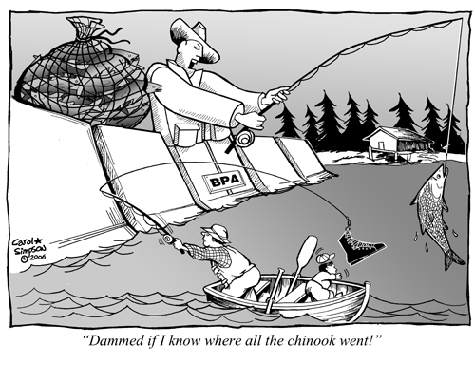forum
library
tutorial
contact

Judge Tells Government to Start Over
on Upper Snake River Plan
by Jeff Barnard, Associated Press
Seattle Post-Intelligencer, November 25, 2005
|
the film forum library tutorial contact |

|
Judge Tells Government to Start Over
by Jeff Barnard, Associated Press
|
 GRANTS PASS, Ore. -- The federal government needs to start over on its plan for making the operations of federal irrigation projects in southern Idaho safe for salmon, a federal judge decided.
GRANTS PASS, Ore. -- The federal government needs to start over on its plan for making the operations of federal irrigation projects in southern Idaho safe for salmon, a federal judge decided.
U.S. District Judge James Redden ruled Tuesday that NOAA Fisheries and the U.S. Bureau of Reclamation must consider the effects a dozen irrigation projects on the upper Snake River have on salmon in conjunction with the operations of hydroelectric dams on the lower Snake and Columbia rivers - not separately.
"Rebuilding salmon to healthy, harvestable levels will come in large part from addressing the impacts of the down-river dam operations that do the most harm to salmon," Redden wrote. "Even so, the water of the upper Snake projects and its uses must be an integral part of the analysis."
Members of Idaho's congressional delegation issued a joint statement criticizing the ruling, saying Redden's decision threatened a huge water rights agreement between the state, federal government and the Nez Perce Tribe over water in the Snake River Basin.
"Once again, a federal judge is trying to run the river with blatant disregard for the critical needs of the Northwest," Sens. Larry Craig and Mike Crapo and Reps. C.L. "Butch" Otter and Mike Simps said in the prepared statement. "He is clearly advocating for one side while ignoring the necessary balance between people and the environment."
Rebecca Miles, the chairman of the Nee Perce Tribe, said the tribe was committed to the water agreement and "we look forward to addressing the impact of the lower Snake river and mainstem Columbia River dams on salmon."
Under the Endangered Species Act, NOAA Fisheries must evaluate whether federal projects such as dams and irrigation projects jeopardize the survival of threatened and endangered species, such as salmon. If the conclusion is that they do, then steps must be taken to overcome the harm, such as releasing more water, or modifying the dams.
Redden ruled a year ago that the Bush administration's 2004 plan for making the hydroelectric dams on the lower Snake and Columbia safe for threatened and endangered salmon violated the Endangered Species Act, in part because it considered the dams as part of the landscape and only considered changes in how the dams were operated.
Referring to his earlier ruling, the judge wrote that NOAA Fisheries, the Bureau of Reclamation and the Bonneville Power Administration, which sells the power produced by the dams, "have failed to demonstrate a willingness to put the needs of salmon first, or to commit the resources necessary to implement mitigation measures."
NOAA Fisheries has appealed the ruling.
The ruling won praise from environmental groups.
"This is an important day for Idaho's salmon and the people who depend on them," said Bill Sedivy with Idaho Rivers United. "It's time to look at the entire system. The modest salmon returns we're seeing in Idaho this year show us again that the status quo isn't working."
Environmental groups also challenged the validity of the 2005 biological opinion governing operations of irrigation projects on the Snake River above Hells Canyon, which make life tougher for salmon by diverting large amounts of water that would otherwise go downstream.
Their hope was that when the two parts of the basin were considered together, the government would have to conclude that the only way to save salmon was to remove four hydroelectric dams on the lower Snake in Eastern Washington.
"This will clarify the true cost of trying to recover Snake River salmon with the lower Snake River dams in place, and bring the trade-offs into focus," said Michael Garrity of American Rivers, an environmental group. "We believe that there is a solution that allows Idaho farmers to keep their water and that recovers Snake River salmon and steelhead, and it is removing the four high-cost, low-value lower Snake dams.
Those who insist that these four dams remain in place are increasing the likelihood that more Idaho water will be needed to help salmon get downstream."
Bill McDonald, northwest regional director of the Bureau of Reclamation, said the ruling was not unexpected, and that the government disagreed with it.
The specifics of going forward depend on further orders the judge indicated he would give, and the outcome of the pending appeal of the biological opinion for the lower Snake and Columbia, he added.
learn more on topics covered in the film
see the video
read the script
learn the songs
discussion forum
